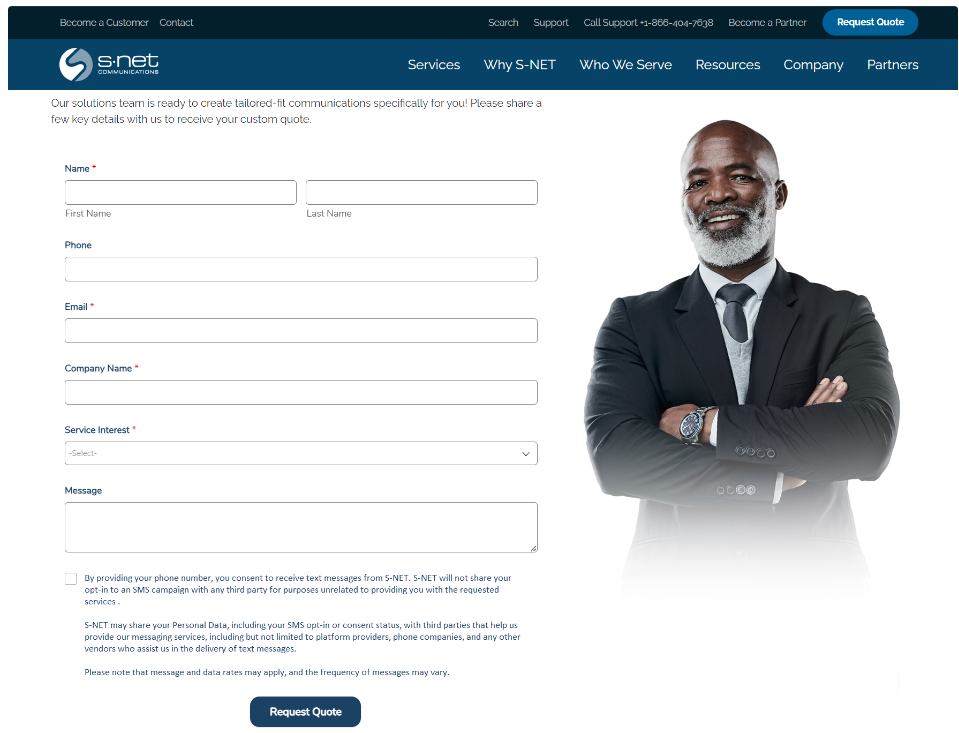10DLC Compliance
For 10DLC compliance, clients need to provide specific information to their account manager and take action to ensure their own systems, websites, and messaging practices are in line with regulations. Here’s what a client should do to comply:
1. Prepare Business Information
Clients will need to provide the following to the account manager:
- Legal Business Name: Ensure your business name matches any official records and documents. If you use a DBA, be sure to include that as well.
- Employer Identification Number (EIN): Have your EIN ready to verify your business.
- Business Type and Industry Category: Confirm your business type (LLC, corporation, etc.) and the industry you operate in (e.g., retail, healthcare).
- Contact Information: Ensure accurate phone numbers and email addresses for business contacts.
What the client should do: Make sure all business details are up-to-date and consistent across your public platforms and legal documents.
2. Campaign Use Case Registration
The account manager will ask for details about the messaging campaign, including:
- Campaign Purpose: Explain what type of messages you’ll be sending (e.g., marketing, client service notifications).
- Sample Messages: Provide examples of the messages you’ll send to ensure they align with compliance standards.
- Opt-In/Opt-Out Mechanisms: Show how you will collect recipient consent and how users can opt out of receiving further messages.
What the client should do:
- Update your website and communication platforms with clear opt-in language, detailing how clients consent to receive messages.
- Ensure your privacy policy includes how you handle client data, how you’ll use their phone numbers for messaging, and their rights to opt out. It should cover data collection for messaging campaigns to comply with privacy regulations.
- If you don’t have an internal resource to make changes to your website, you may have to reach out to your provider for changes. This could take some time. This will need to be done prior to the campaign submission as this is part of the verification process.
Example:

3. Message Volume and Consent Management
The account manager will need to know:
- Message Volume: Estimate how many messages you plan to send weekly or monthly.
- Recipient Consent: Provide proof of recipient opt-ins. Make sure consent is verifiable to meet compliance standards.
What the client should do:
- Implement or update consent collection mechanisms (e.g., sign-up forms, checkboxes) on your website or app.
- Set up clear and easily accessible opt-out instructions in every message, and automate opt-out confirmations (e.g., an immediate “You have been unsubscribed” message).
4. The Campaign Registry (TCR) Requirements
Your account manager will register your campaign with The Campaign Registry (TCR) and may ask for:
- Campaign Details: A full description of your campaign’s objectives and the types of messages sent.
What the client should do:
- Make sure your campaign details are fully documented, from the message’s intent to frequency. Ensure this documentation is consistent with what’s presented to your clients.
5. Website and Communication Updates
Update Your Website and Privacy Policy: Clearly communicate how your business handles client information for messaging campaigns. Ensure your privacy policy complies with regulations related to text messaging and data protection laws (such as GDPR or CCPA). This should include:
- How you collect phone numbers.
- What kind of messages clients can expect.
- Their rights to withdraw consent and opt-out procedures.
- Consent Collection: Ensure that all sign-up forms for receiving messages have explicit opt-in consent, with clients understanding they’ll receive text messages.
6. Content Compliance and Review
Your account manager may ask for message samples to ensure compliance with carrier and anti-spam regulations.
What the client should do:
- Review your message templates with your CTA a couple times a year to ensure they are not misleading, overly promotional, or spammy.
- Make sure your messages include business identification and offer clients an easy way to opt out.
7. Additional Fees and Costs
The account manager may inform you of any associated fees for SMS/10DLC setup or ongoing compliance.
What the client should do:
- Budget for these fees, which may be monthly or annual, depending on the scope and scale of your SMS usage.
Summary
Clients should provide the necessary business, campaign, and consent information to their account manager while also taking action to update their websites, privacy policies, and communication practices. Ensuring compliance at all these levels helps maintain a seamless relationship with carriers and ensures 10DLC campaigns are approved and operate without disruptions.
